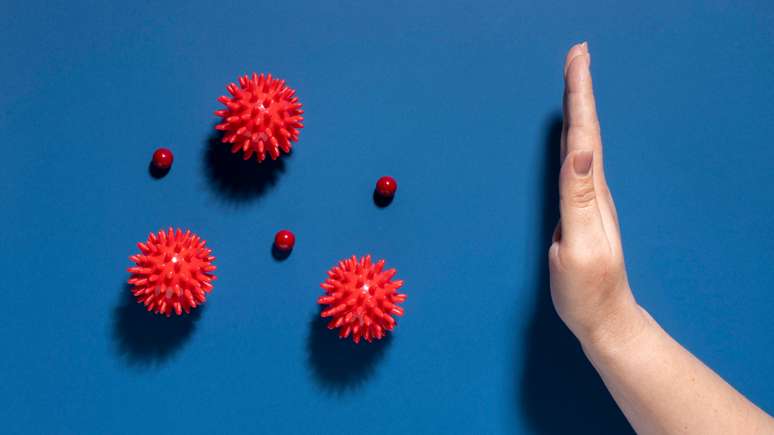Herpes, mycosis and candidiasis are some of the opportunistic diseases, i.e. that manifest themselves from the imbalance of the immune system, mentioned by Jamar Tejada
“Kid, put on a slipper! Don’t walk barefoot on that cold floor!”, “You have to eat spinach to be strong!”, “Eat everything so you don’t get sick!”, “Don’t eat that, it’s dirty! worms!”. What a blessing it would be if we could grow up hearing this kind of warning and rebuke. It would be a sign that our family takes care of us.
html[data-range=”xlarge”] figure image img.img-1b4ec07f62a0dd6fc0e214d434620bc2vkshjnd0 { width: 774px; height: 435px; }HTML[data-range=”large”] figure image img.img-1b4ec07f62a0dd6fc0e214d434620bc2vkshjnd0 { width: 548px; height: 308px; }HTML[data-range=”small”] figure figure img.img-1b4ec07f62a0dd6fc0e214d434620bc2vkshjnd0, html[data-range=”medium”] figure image img.img-1b4ec07f62a0dd6fc0e214d434620bc2vkshjnd0 { width: 564px; height: 317px; }
To maintain our health, it is known that it is possible only with a balanced immune system. That old explanation of the “defense army” inside our bodies makes perfect sense, after all, that’s how it happens. There is a daily battle within our corps and when we have a significant loss of our soldiers, the enemy takes over.
Immune System: What Happens When It’s Out of Balance?
Herpes, mycosis and candidiasis are the most common diseases that exploit this imbalance, which is why they are called opportunistic diseases. Have you noticed that these diseases always appear when you are having a hard time?
Factors such as stress, poor diet, sadness, cigarettes, drug use, pollution, sleep deprivation, excessive exercise, extreme temperatures (too hot or too cold) can interfere with defense barriers of our body.
The problem can be compounded by the age factor, as we lose our battle strength over time. From the age of 50, a process called immunosenescence begins, the aging of the immune system. In this way, the individual becomes more prone to infections, autoimmune diseases and even cancer, as well as reducing the response to the vaccine.
In this period, the importance of care with vaccination and above all food grows. The older they are, the more care we must have with our soldiers in the fight against protozoa, bacteria, fungi and viruses. Our immunity is made up of a set of cells that protect us from external threats, such as microorganisms and which also have the function of fighting the abnormal cells produced by the body itself.
It is one thing to have our immune system at a low level, due to external factors or even age, and another thing when there is an immune deficiency, the so-called immunodeficiency, which can be primary, i.e. genetic, or secondary, where HIV enters, a virus that attacks our defenses. These diseases make us susceptible to opportunistic diseases.
The development of the immune system
We should also know that our immune system is not born ready. It develops and becomes an “adult” around the age of 10 or 12. This shows why children are more prone to infections. Some babies acquire an adult immune system sooner, others later, and this will also depend on several points, such as, for example, the type of delivery, whether it was a cesarean section or a normal delivery, or whether breastfeeding is was done with breast milk. , if you live with smokers, if you have contact with nature, with the earth, the type of diet, exposure to diseases, etc.
Although there is no magic to increase our guardian cells, it is known that the consumption of healthy foods is welcome, especially fruits, vegetables and raw greens, which can satisfy the body’s vitamin needs.
Adequate sun exposure is also recommended as vitamin D is essential for our immune system. Furthermore, ensuring the necessary hours of sleep (which vary from person to person), not smoking, not abusing alcohol and – needless to say – not consuming illicit drugs. Of course, underlining less is one of the important points, but it is almost impossible to demand it in today’s times. So, with vegetables, don’t forget a lot of prayer and meditation!
How does the opportunistic infection process work?
It is natural that different colonies of bacteria, protozoa, fungi and viruses live in the human body, so much so that the vast majority usually do not cause disease, as they are controlled by the immune system, ensuring a harmonious coexistence. We have in each of us a large particular universe of all these microorganisms, the so-called microbiota, which is unique, just as the fingerprint of each of us is unique.
The problem is when the immune system is weakened, these same germs proliferate massively, causing opportunistic infections, which can become difficult to treat and can lead to life-threatening conditions.
Two examples of opportunistic infections:
CANDIDIASIS
It is an infection caused by the Candida albicans fungus, which affects about 75% of women, and which is present on the skin and on the oral and vaginal mucous membranes. A large part of the population is colonized by this microorganism, which is not synonymous with infection.
Any change in the pH of the vagina or alteration of the intestinal flora can lead to the multiplication of the fungus, causing the symptoms, which are usually intense itching, swelling and redness of the vulva and thick white discharge.
Among the risk factors for candidiasis are diabetes, prolonged use of antibiotics – they alter the normal bacterial flora -, pregnancy and the use of chemotherapy. Treatment is based on basic hygiene care, oral antifungals, vaginal creams and sitz baths.
FIRE OF SAINT ANTHONY
Caused by the Herpesviridae virus, herpes simplex has two variants: type 1, which appears in the mouth or on the skin, and type 2, which is more common in the genital region. This type of herpes belongs to the same family as shingles, but of a different species.
Shingles is the manifestation of the chickenpox virus, or varicella, which has been dormant in the body since childhood in those who develop the disease. Inactive for many years, the virus remains lodged in the nerve cells of the spine and head.
If you do blood tests, most people will test positive for herpes. But much of it will not manifest throughout life. In smaller numbers, it appears at some point, especially among the elderly.
Herpes gives the first indications by causing tingling, heat and itching in the affected region. A few days later, blisters appear on the skin in a large band on one side of the body. These bands correspond to nerve cells where the virus has been activated. In two to three weeks, the rashes turn into crusts, causing intense pain, which can last for years in the patient.
Contamination between people occurs through skin-to-skin contact, but it also occurs through objects such as straws, cups and even towels. In children, there may be a picture of herpetic stomatitis, which is more canker sores in the mouth. This characterizes the first infection of small herpes.
To prevent this problem, it is essential to avoid contact with people suffering from herpes and also avoid excessive exposure to the sun without protection in the area. Treatment is with antivirals prescribed by a doctor. Placing ice or even chamomile compresses on the region can also ease the pain.
Source: Terra
Ben Stock is a lifestyle journalist and author at Gossipify. He writes about topics such as health, wellness, travel, food and home decor. He provides practical advice and inspiration to improve well-being, keeps readers up to date with latest lifestyle news and trends, known for his engaging writing style, in-depth analysis and unique perspectives.








